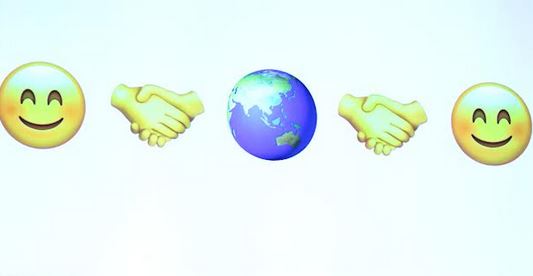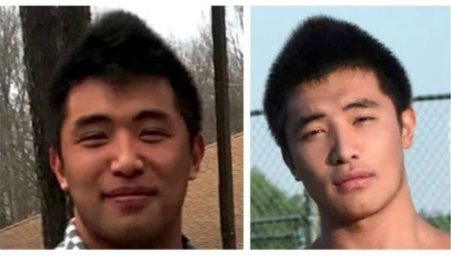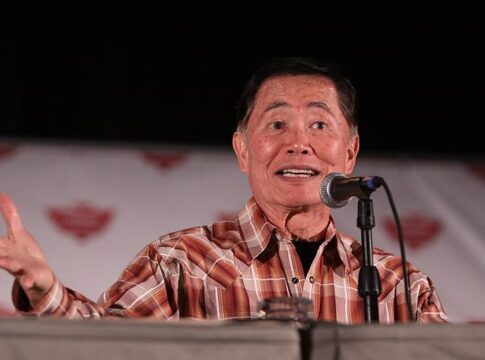By Jana Monji
Japanese interface designer Shigetaka Kurita (栗田穣崇), 51, received a Lifetime Achievement Webby Award Monday night for designing a set of 176 colored emoji.
In a Zoom interview with AsAmNews just before the 27th Annual Webby Awards in New York City, Kurita said when he first heard about it, “I was astonished because I never expected to receive such an award.”
The Webby Awards website notes:
Since creating the first set of 176 emoji in 1999, Shigetaka’s emoji have evolved from rudimentary symbols into uniquely digital forms of communication that transcend cultures, borders, and even language barriers.
Kurita’s work had previously been recognized in the city of New York when in 2016, the Museum of Modern Art put that 176-colored NTT DoCoMo emoji set on display. Although those heavily pixilated symbols may now seem quaint, when Kurita created them in 1999 for use on NTT DoCoMo’s I-mode mobile platform, they were a revelation, starting a pictograph revolution that would spread beyond Japan. According to the Webby Awards, there are now “over 2,600 colorful emoji in use worldwide” and “emoji have also become instrumental in furthering online dialogues about inclusiveness in our symbols, across race, gender identities, abilities, sexual orientation, and beyond.”
LATEST STORIES
Of the 2016 exhibition, Kurita said, “When I was working on them, I certainly didn’t have the expectation that they would end up in an art museum,” graciously adding, “It’s really thanks to everyone who used them worldwide and this showed the power of design in communication.” As a result, Kurita said, “My name will live on.”
Before emoji, there were emoticons. While “emoticon” is a blending of “emotion” and “icon,” “emoji” comes from the “e” for picture (絵) and “moji” for (文字) for “character.” Japanese, like Chinese, is a language filled with pictograms, but so is the Japanese manga culture. With manga there are pictograms called manpu (漫符). Growing up, Kurita, of course, read manga. During the interview he said, “When I was a child, I loved the soccer manga, “Captain Tsubasa” (キャプテン翼). That manga, Kurita noted, is popular worldwide and has even influenced kids to become soccer players. According to an article in Oricon News, the manga has a worldwide circulation of about 90 million as of 2023.
Kurita noted, “Manpu are symbols used to describe people’s emotion in manga, like sweat coming from someone’s face.” But sweat drops don’t just mean someone is running on the soccer field. It can also mean “uncertainty, embarrassment, fear” according to Anime Art Magazine.

Before Kurita’s emoji set, the heart pictogram proved to be a game-changer. When the heart pictogram debuted on a 12-character NTT DoCoMo pocket pager, it was widely popular–so much so that when it was dropped by NTT DoCoMo in its next model, there was an outcry. NTT DoCoMo brought it back.
Kurita had been part of the heart development team and even today, the heart is Kurita’s favorite emoji because, he says, “You can add it to any negative word and it can it into something positive. The heart is the strongest emoji.”
While manga have certainly become international, Kurita said of the emoji, ” At first I thought it would just fit countries that use kanji (Chinese characters as used in Japanese), but around 2010 with the diffusion of smartphones, when English-speaking countries began to use it that’s when I first realized the potential outside of kanji-using countries. I was surprised.”
While emoji are now one of Japan’s most successful exports, there’s another, older Japanese icon that doesn’t have an emoji: Godzilla. When Kurita admitted with a laugh, there wasn’t a Godzilla emoji, but he said that if there were a worldwide outcry then perhaps there would be one developed in the future.
Kurita’s message for the world at the Webby Awards, in which awardees are limited to a five-word acceptance speech was:
😊🤝🌏🤝😊
AsAmNews is published by the non-profit, Asian American Media Inc. Follow us on Facebook, X, Instagram, TikTok and YouTube. Please consider making a tax-deductible donation to support our efforts to produce diverse content about the AAPI communities. We are supported in part by funding provided by the State of California, administered by the California State Library in partnership with the California Department of Social Services and the California Commission on Asian and Pacific Islander American Affairs as part of the Stop the Hate program. To report a hate incident or hate crime and get support, go to CA vs Hate.










